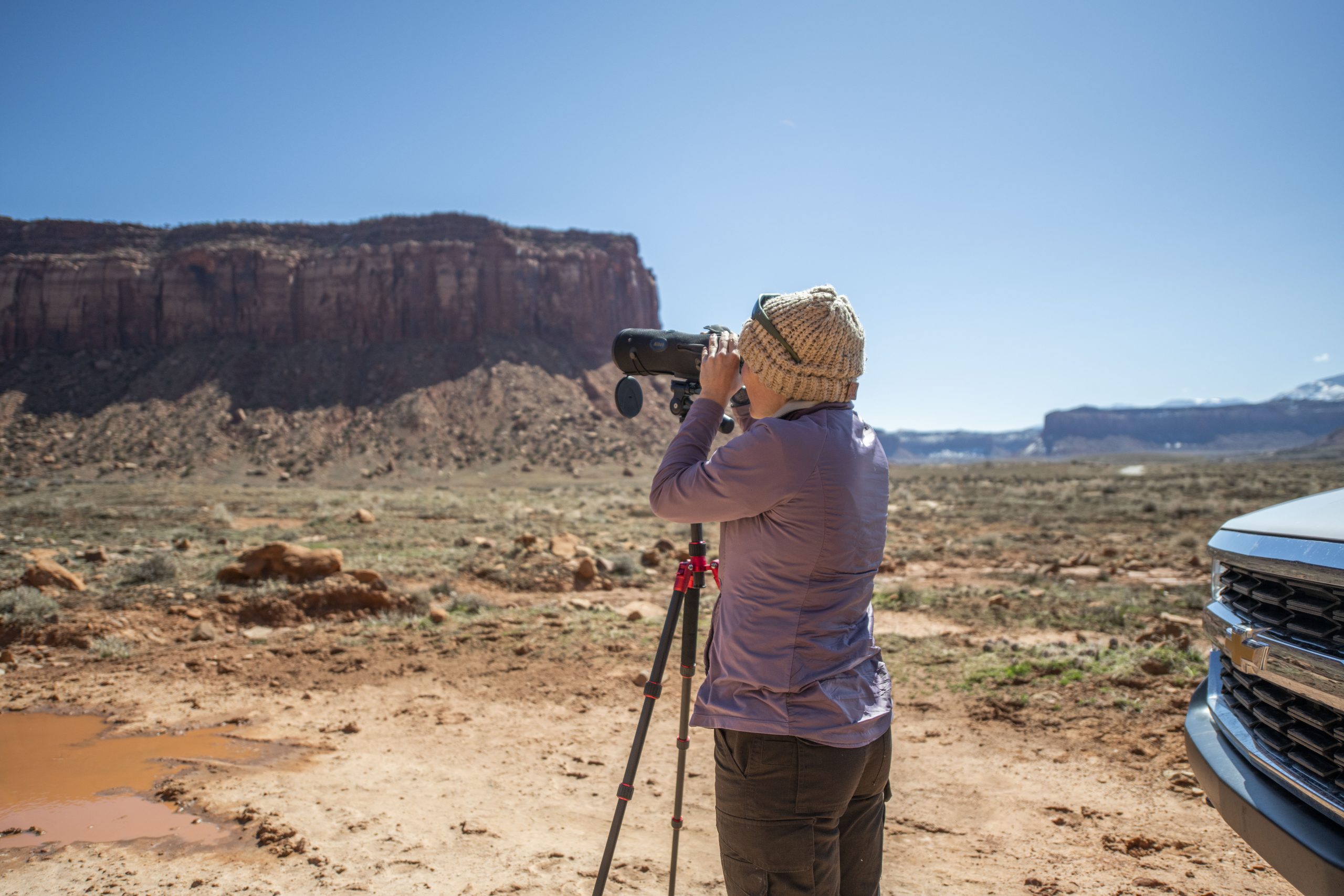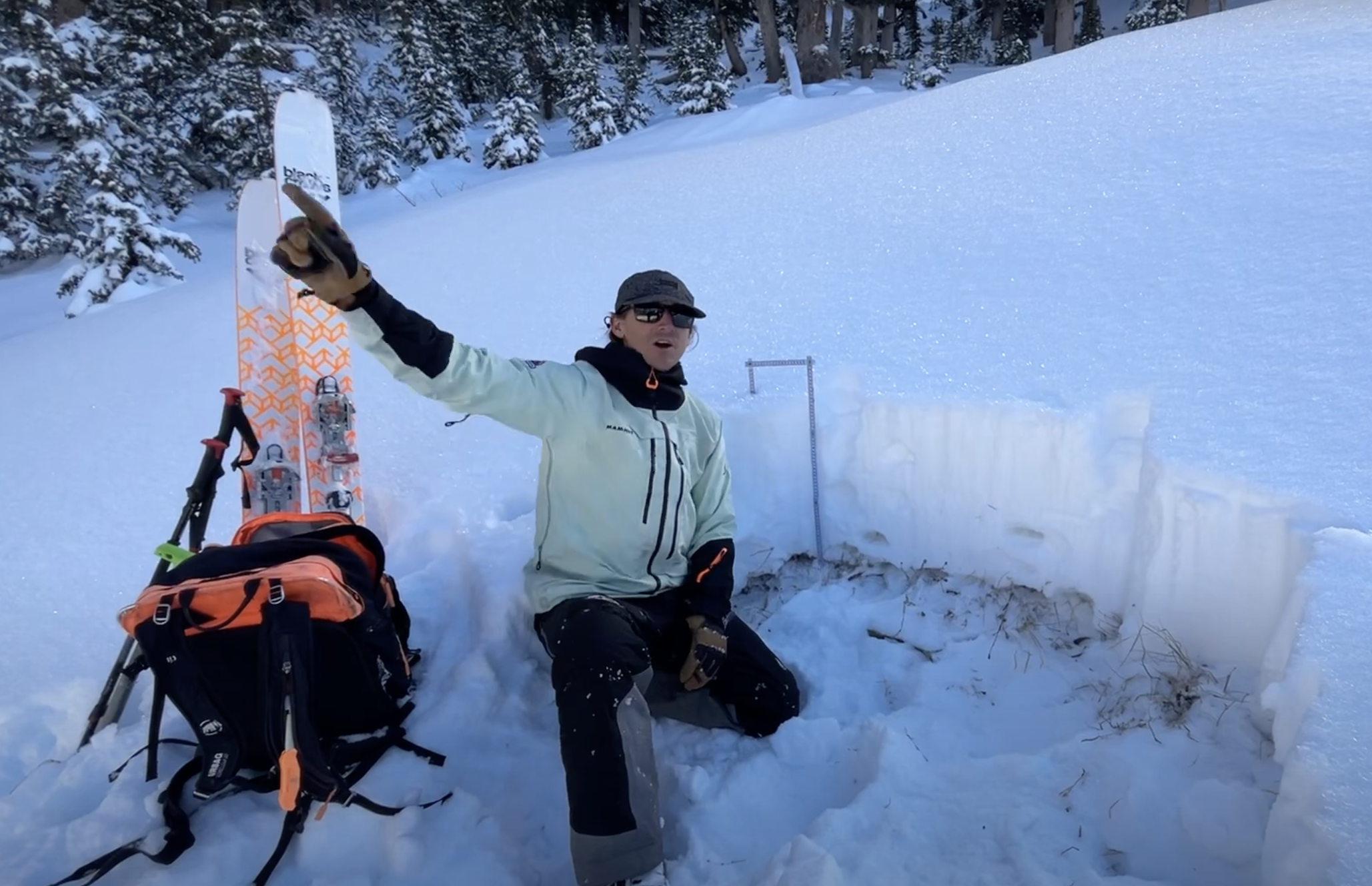Some information may be outdated.
“The thing about Indian Creek,” said Melissa Wardle, “is that if you sit here for long enough, you’ll find something.”
Wardle, the Bureau of Land Management’s Monticello wildlife biologist, says this as she peers through a spotting scope aimed at Reservoir Wall, a cliff within the Indian Creek area of the Bears Ears National Monument.
While Indian Creek is renowned for its rock climbing—the towering cliff walls splinter into cracks that are hundreds of feet long—Wardle isn’t looking for climbers trying their hands at tough routes. She’s searching for evidence of golden eagles (the Utah state bird of prey), peregrine falcons, and other raptors that have used the climbing crags as nesting areas for generations, and on a brisk spring morning, she allows me to join her.

Reservoir Wall, home to climbs like “Slot Machine” (5.11 b/c) and “Pente” (5.11-), is currently marked as an avoidance area by the BLM—the organization is asking climbers and recreationists to avoid a total of 11 walls to ensure the survival of young raptors. If nest areas are disturbed, the adult birds may abandon the nest and their young; if young birds are spooked and try to leave the nest too early, they could die. These types of protections fall under the Migratory Bird Treaty Act.
Plus, raptors are an indicator species, Wardle said. When their populations are doing well, that typically means the rest of the food chain is functioning as it should, too. By keeping an eye on the birds, wildlife biologists can keep an eye on the entire system.
Wardle said most years, six or seven regular nesting families return to Indian Creek—the BLM has tracked the raptors and established the avoidance areas since at least 2006. The birds will often return to the exact nest sites they’ve used in the past: right now, Wardle is trying to identify which nests are active, both so the BLM can keep an eye on young birds as they develop and later open any areas the birds aren’t in.
Wardle and two other biologists do this raptor surveying every spring—they’ll each spend at least one day a week in Indian Creek keeping an eye on the birds. Typically, the BLM will know where active nests are by late April or early May, but not always—last year was so quiet and the signs of the birds so few and far between, Wardle kept the avoidance notice active for all 11 walls, just in case. Each year, the avoidance notice is lifted in total sometime in late summer, once the birds have fledged.


Wardle looks for signs of nesting birds everywhere. She keeps an eye on old nests, listens for sounds of food transfers between nesting mates (one bird will hunt while the other incubates the egg; when they transfer food, they’re quite loud), looks for whitewash (poop stains on the wall beneath a nest), and, of course, peers at the skies through her binoculars and spotting scope.
Wardle drives us out to a road near another climbing wall where eagles have nested before—it’s possible this season’s birds could use the nest, and she wants to show me what nest areas look like. We drive a few hundred feet beyond the closed gate so Wardle can hop out, set up her scope, and locate the nest.
We look for birds too: if we see a raptor, Wardle will try to follow it in her binoculars to see if it heads toward a nest. If it doesn’t, that’s still a good sign—Wardle said she’ll keep returning to the area to see what the bird might do in the future. Seeing two birds at once is even better, because it’s a sign the two could be mates.
Wardle finds the old nest site through her scope. It’s in a clever spot, tucked into an alcove on a north-facing cliff. Wardle explains that baby birds, covered in downy feathers, can keep themselves warm with the help of their parents, but can’t keep themselves cool—if the nest was on a south-facing cliff, it’s possible the chicks could die in the relentless sunshine.
Then, success! Wardle spots a golden eagle perched on top of the cliff. Then, more excitement! The bird starts an undulating flight, flying up, up, up, then tucking its wings beneath itself to dive. The flight is rhythmic, up, down, up, down, and is also a fantastic nesting sign: birds doing such flights could be marking their territory or showing off for a mate. Wardle and other raptor survey staff will return to this spot to watch this bird; hopefully, Wardle said, it’ll set up a nest.
Wardle said she tries not to anthropomorphize the birds, but it’s hard not to romanticize the thought of this eagle soaring and showing off for its lifelong mate. We imagine the mate is perched just out of view; we imagine that just as we’re staring at the bird, it might be keeping us in the corner of its eye, too. The eagle flies up and dives once more before its wings catch the wind and carry it behind the cliff.
“These birds have nested here for probably hundreds of years,” Wardle said. “One of the comments I usually get is, ‘there’s plenty of space for the birds, can’t they go somewhere else if they’re disturbed?’ But they’ve been coming to these spots for generations. I think there’s just an importance to that.”
•••
In land management plans across the entire country, the BLM balances land health, recreation, cultural and scenic values, and commercial uses like ranching and resource extraction. The BLM and U.S. Forest Service are currently undergoing a process to update the land use plan for Bears Ears National Monument; nesting raptors have been considered in management plans for the monument since it was established in 2016. The BLM relies on climbers honoring these partial cliff closures in the spring to allow the natural inhabitants to thrive. As more and more climbers visit Indian Creek, land managers and recreation advocates have increased efforts to limit impacts from visitation—impacts not just on wildlife, but also on plants, soils, biocrusts and cultural resources.
Modern climbing in Indian Creek was first documented in the 1960s, with a few daring athletes establishing a handful of routes. In 1978, the introduction of a new piece of climbing equipment—camming devices called “Friends” made by the company Wild Country—made climbing Indian Creek’s parallel cracks safer and more accessible. Over the following decades, the unique, challenging and scenic routes drew more and more climbers to Indian Creek.
Now, Indian Creek has over 1,300 established routes; on popular weekends in the spring and fall, the area sees hundreds of climbers. Visitation has risen quickly enough that in 2021, the climbing advocacy nonprofit The Access Fund and the BLM launched a program that employs two “Climber Stewards” to be on-the-ground recreation educators.

Stewards set up at popular campgrounds and parking lots to connect with climbers and teach them about ethical recreation practices in the desert: leave no trace, respect archaeological sites, and now, avoid raptor nesting areas.
The BLM has started to introduce its own staff to conduct outreach to the thousands of visitors alongside the climbing stewards: Wardle sets up her spotting scope near climber coffee events and local BLM archaeologists like Audrey Pefferman talk to visitors about cultural sites in the area. The vibe is jovial and friendly—everyone is there to field any and all questions.
The work is essential: Pefferman said she’s been shocked that visitors have asked if the petroglyphs in the area are real or fake. She assured them that the petroglyphs are very real, and asked them to please visit respectfully.
“Climbers can be so focused on the climbing itself that often, it’s difficult to see the bigger picture. Partnering with the BLM, having access to experts, provides a great opportunity to provide resources for people to make their own decisions,” said Wes, one of this year’s climbing stewards. “I want everyone to be able to have those climbing experiences that we’re able to have here, but there’s a way you can do it to minimize your impact and honor the history of the land.”
On popular days, Wes said he and the other climbing steward, Chandler, talk with hundreds of people. Their conversations are extremely productive—Wes said all the climbers he’s interacted with so far are curious about and willing to learn how to become better recreationists. He and Chandler both said they hope climbers can take what they learn in Indian Creek and apply it to crags across the nation—there are ways to be better stewards everywhere, they said.
“Stewardship is so much about action,” Chandler said. “If you’re not willing to take action, then your stewardship isn’t going to go very far. Being here, being a climber steward, is so different from just spending a season living in the Creek climbing. To be a part of a resource that gives back to the space—to learn about how to give back to the space—shows how much we love it.”
Appreciate the coverage? Help keep local news alive.
Chip in to support the Moab Sun News.





